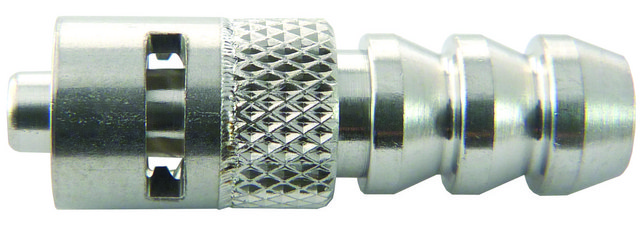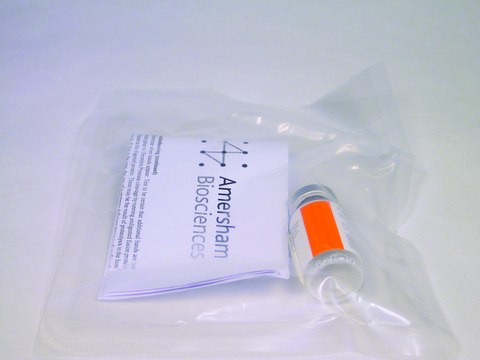95348
Abberior® STAR 470SX, NHS ester
for long Stokes STED and 2-color STED application
Sign Into View Organizational & Contract Pricing
All Photos(1)
About This Item
UNSPSC Code:
12352200
Recommended Products
Assay
≥80.0% (degree of coupling)
form
solid
solubility
DMF: 1 mg/mL, clear
fluorescence
λex 480 nm; λem 610-630 nm in PBS, pH 7.4
storage temp.
−20°C
General description
Abberior STAR 470SX is the latest development of long-Stokes-Shift dyes for STED microscopy. The dye can be excited from 450 to 480nm. It can substitute dyes like Chromeo™ 494. For STED, a depletion wavelength ~750 nm is recommended. It is therefore well suited for 2-color STED imaging as implemented in the Leica TCS STED Ti:Sa microscope.
Abberior STAR 470SX is the dye of choice for long Stokes STED applications in the orange fluorescent regime. The dye is particularly designed and tested for 2-color STED microscopy in combination with our STAR 635 using a single STED wavelength. The dye is our recommendation for usage in the Leica TCS STED Ti:Sa 2-color system.
Key Features
Absorption Maximum, λmax: 475 nm (MeOH),
477 nm (PBS, pH 7.4)
Extinction Coefficient, ε(λmax): 30′400 M-1cm-1 (MeOH),
22′700 M-1cm-1 (PBS, pH 7.4)
Correction Factor, CF260 = ε260/εmax: 0.69
Correction Factor, CF280 = ε280/max: 0.47
Fluorescence Maximum, λfl: 609 nm (MeOH),
627 nm (PBS, pH 7.4)
Recommended STED Wavelength, λSTED: 740 - 770 nm
Fluorescence Quantum Yield, η: 0.80 (EtOH)
Fluorescence Lifetime, τ: 3.9 (EtOH)
Abberior STAR 470SX is the dye of choice for long Stokes STED applications in the orange fluorescent regime. The dye is particularly designed and tested for 2-color STED microscopy in combination with our STAR 635 using a single STED wavelength. The dye is our recommendation for usage in the Leica TCS STED Ti:Sa 2-color system.
Key Features
- Designed for STED microscopy at ~750 nm
- Long Stokes′ shift (>130 nm) for 2-color applications
- Tested in the Leica TCS STED Ti:Sa 2-color system
Absorption Maximum, λmax: 475 nm (MeOH),
477 nm (PBS, pH 7.4)
Extinction Coefficient, ε(λmax): 30′400 M-1cm-1 (MeOH),
22′700 M-1cm-1 (PBS, pH 7.4)
Correction Factor, CF260 = ε260/εmax: 0.69
Correction Factor, CF280 = ε280/max: 0.47
Fluorescence Maximum, λfl: 609 nm (MeOH),
627 nm (PBS, pH 7.4)
Recommended STED Wavelength, λSTED: 740 - 770 nm
Fluorescence Quantum Yield, η: 0.80 (EtOH)
Fluorescence Lifetime, τ: 3.9 (EtOH)
Application
Abberior® STAR 470SX goat anti-rabbit antibody has been used for STED (stimulated emission depletion) microscopy in Caco-2 cells.
Suitability
Designed and tested for fluorescent super-resolution microscopy
Other Notes
Legal Information
Chromeo is a trademark of Active Motif Chromeon GmbH
abberior is a registered trademark of Abberior GmbH
related product
Storage Class Code
11 - Combustible Solids
WGK
WGK 3
Flash Point(F)
Not applicable
Flash Point(C)
Not applicable
Regulatory Information
新产品
Choose from one of the most recent versions:
Certificates of Analysis (COA)
Lot/Batch Number
Don't see the Right Version?
If you require a particular version, you can look up a specific certificate by the Lot or Batch number.
Already Own This Product?
Find documentation for the products that you have recently purchased in the Document Library.
Thommie Karlsson et al.
PLoS pathogens, 8(10), e1002953-e1002953 (2012-10-17)
Quorum sensing (QS) signaling allows bacteria to control gene expression once a critical population density is achieved. The Gram-negative human pathogen Pseudomonas aeruginosa uses N-acylhomoserine lactones (AHL) as QS signals, which coordinate the production of virulence factors and biofilms. These
Marcus Dyba et al.
Nature biotechnology, 21(11), 1303-1304 (2003-10-21)
We report immunofluorescence imaging with a spatial resolution well beyond the diffraction limit. An axial resolution of approximately 50 nm, corresponding to 1/16 of the irradiation wavelength of 793 nm, is achieved by stimulated emission depletion through opposing lenses. We
S W Hell et al.
Optics letters, 19(11), 780-782 (1994-06-01)
We propose a new type of scanning fluorescence microscope capable of resolving 35 nm in the far field. We overcome the diffraction resolution limit by employing stimulated emission to inhibit the fluorescence process in the outer regions of the excitation
Volker Westphal et al.
Physical review letters, 94(14), 143903-143903 (2005-05-21)
Utilizing single fluorescent molecules as probes, we prove the ability of a far-field microscope to attain spatial resolution down to 16 nm in the focal plane, corresponding to about 1/50 of the employed wavelength. The optical bandwidth expansion by nearly
Beitraege zur Theorie des Mikroskops und der mikroskopischen Wahrnehmung.
Abbe, E.
Archiv fur Mikroskopische Anatomie, 9, 413-420 (1873)
Our team of scientists has experience in all areas of research including Life Science, Material Science, Chemical Synthesis, Chromatography, Analytical and many others.
Contact Technical Service



